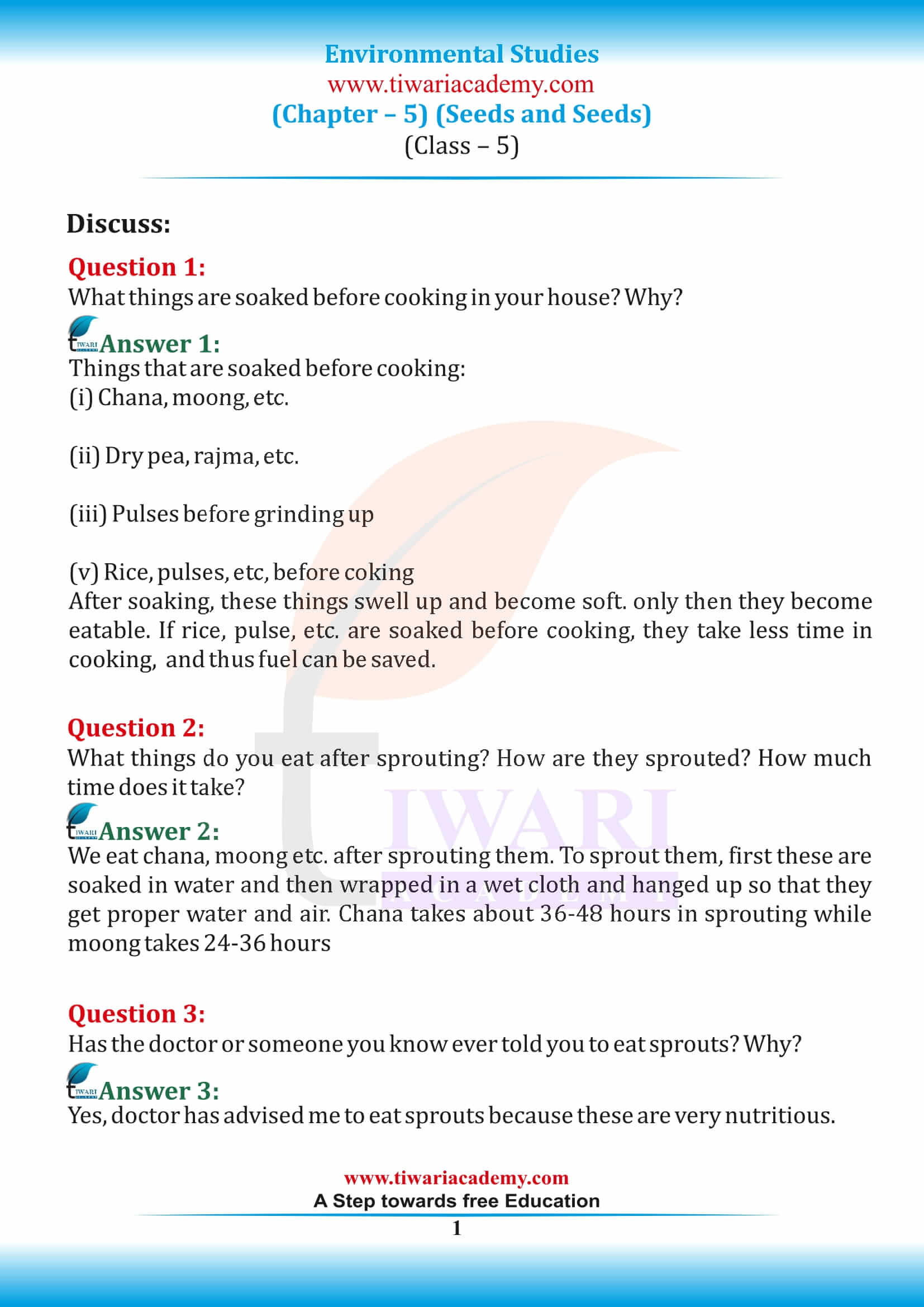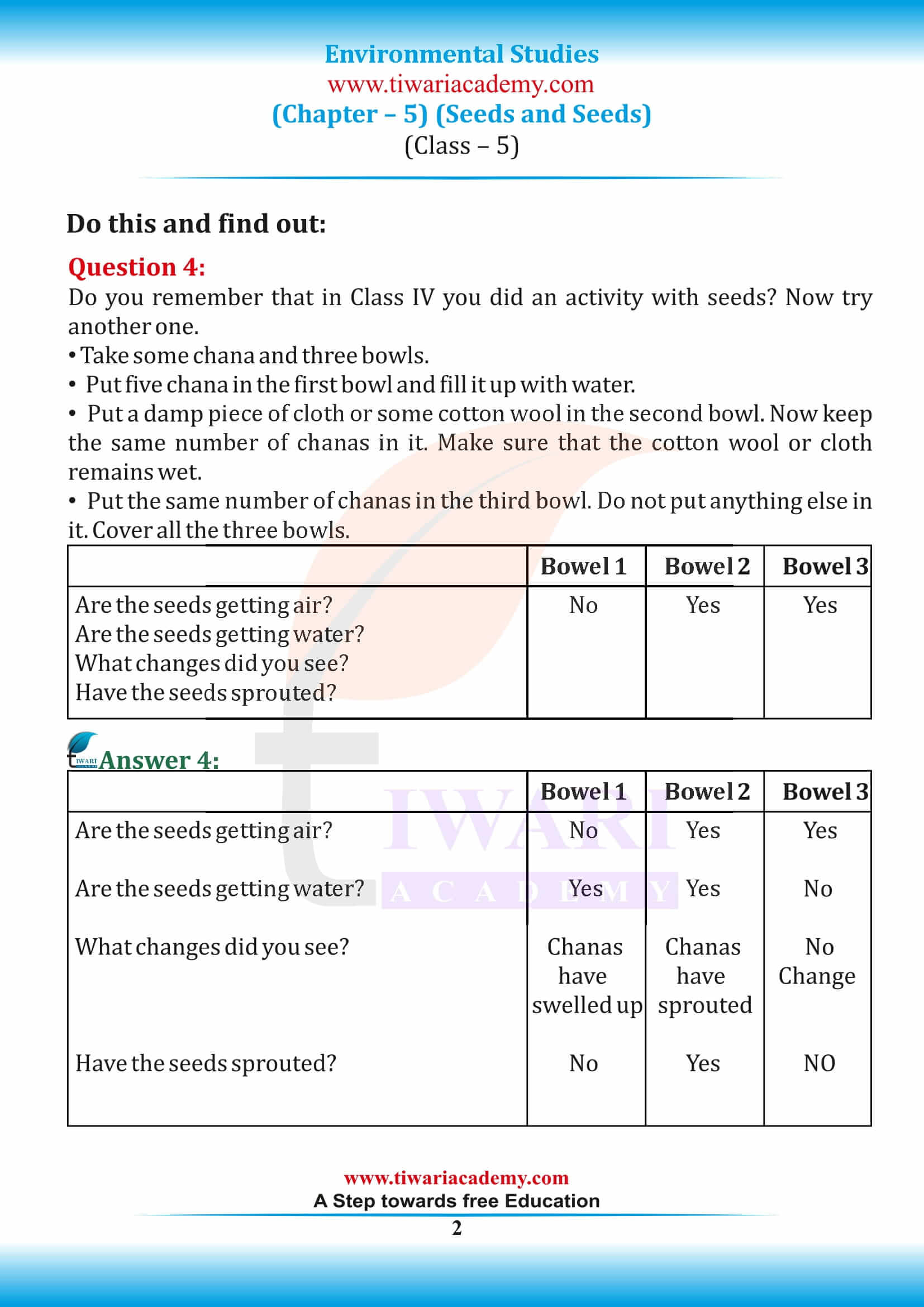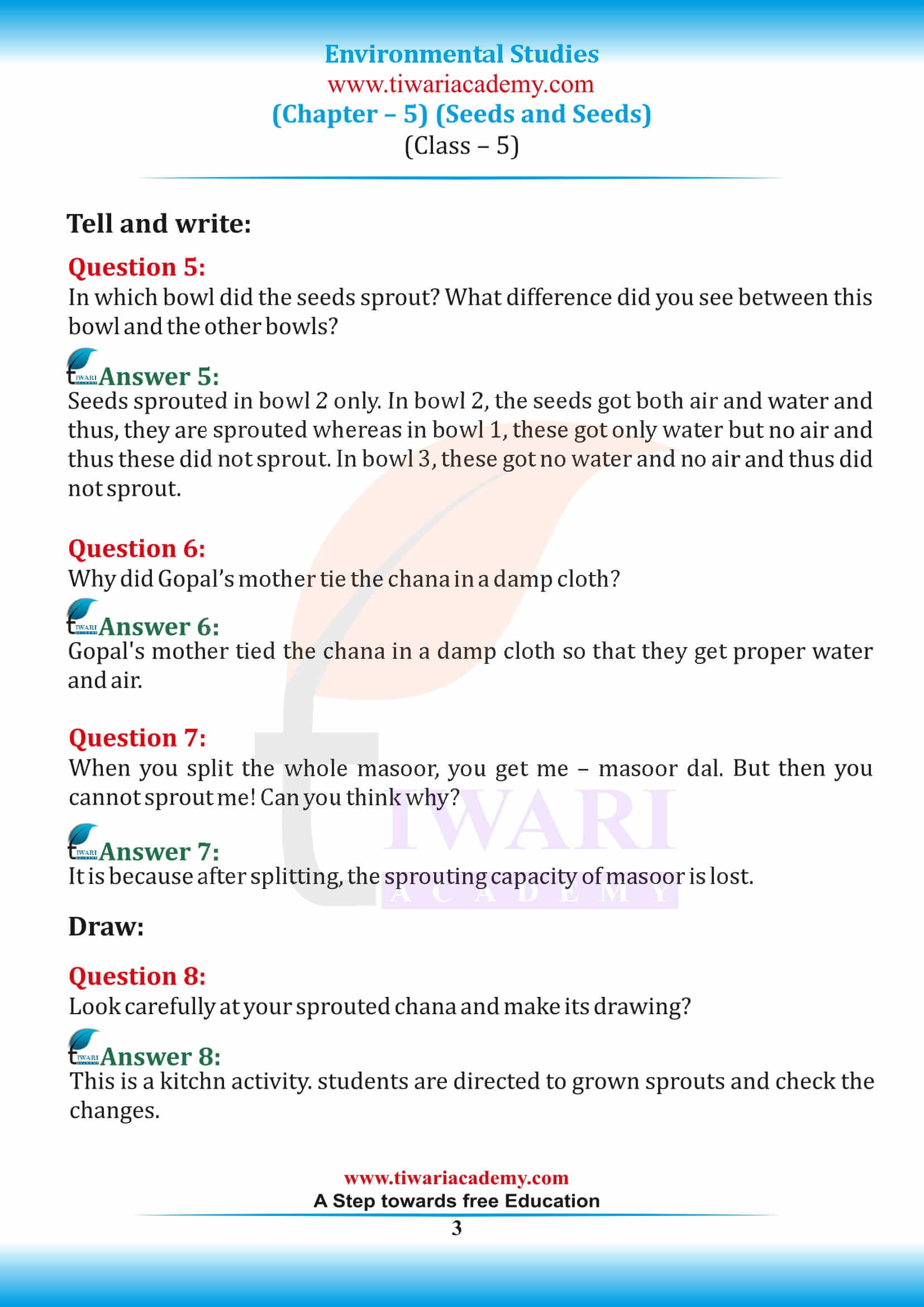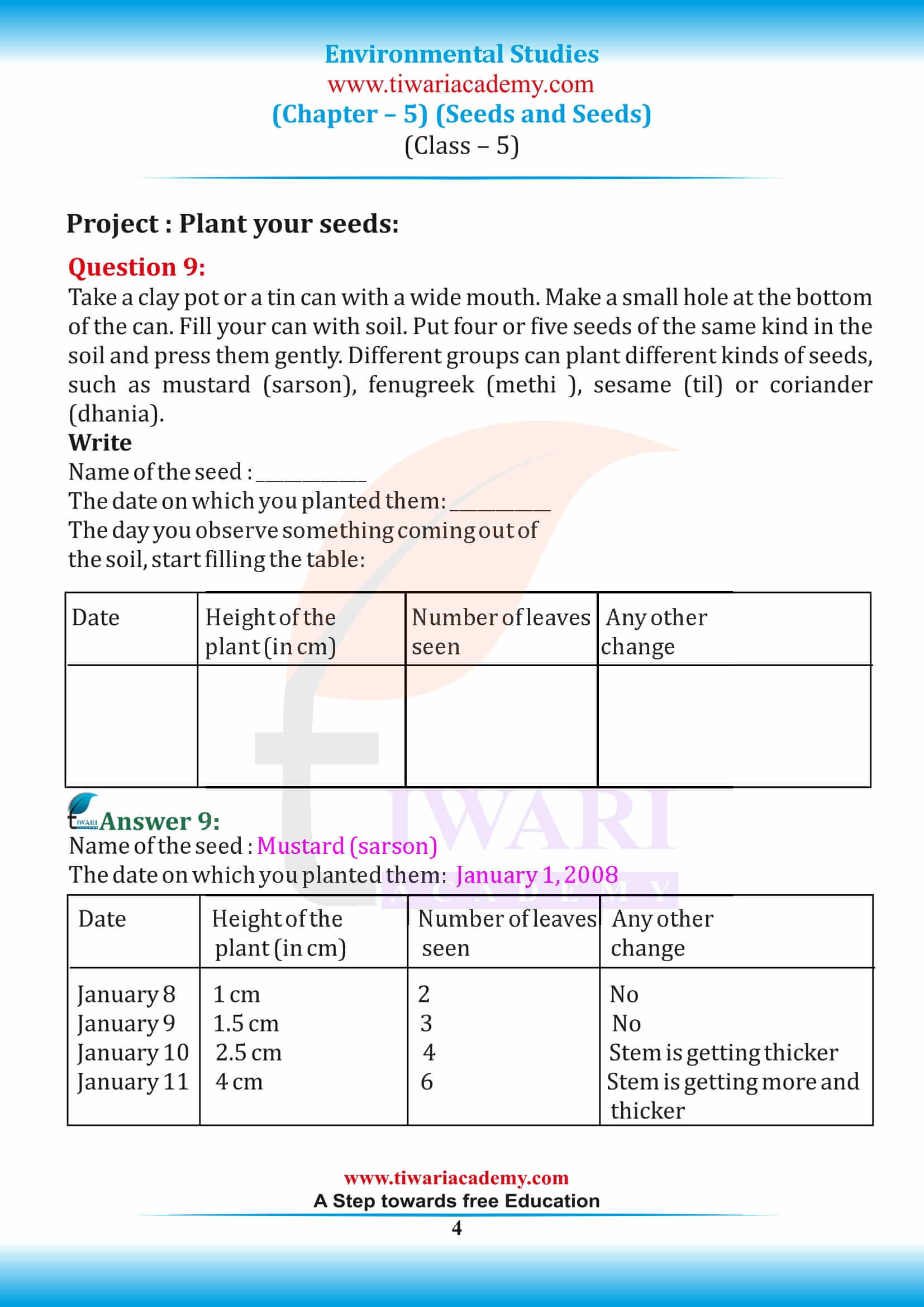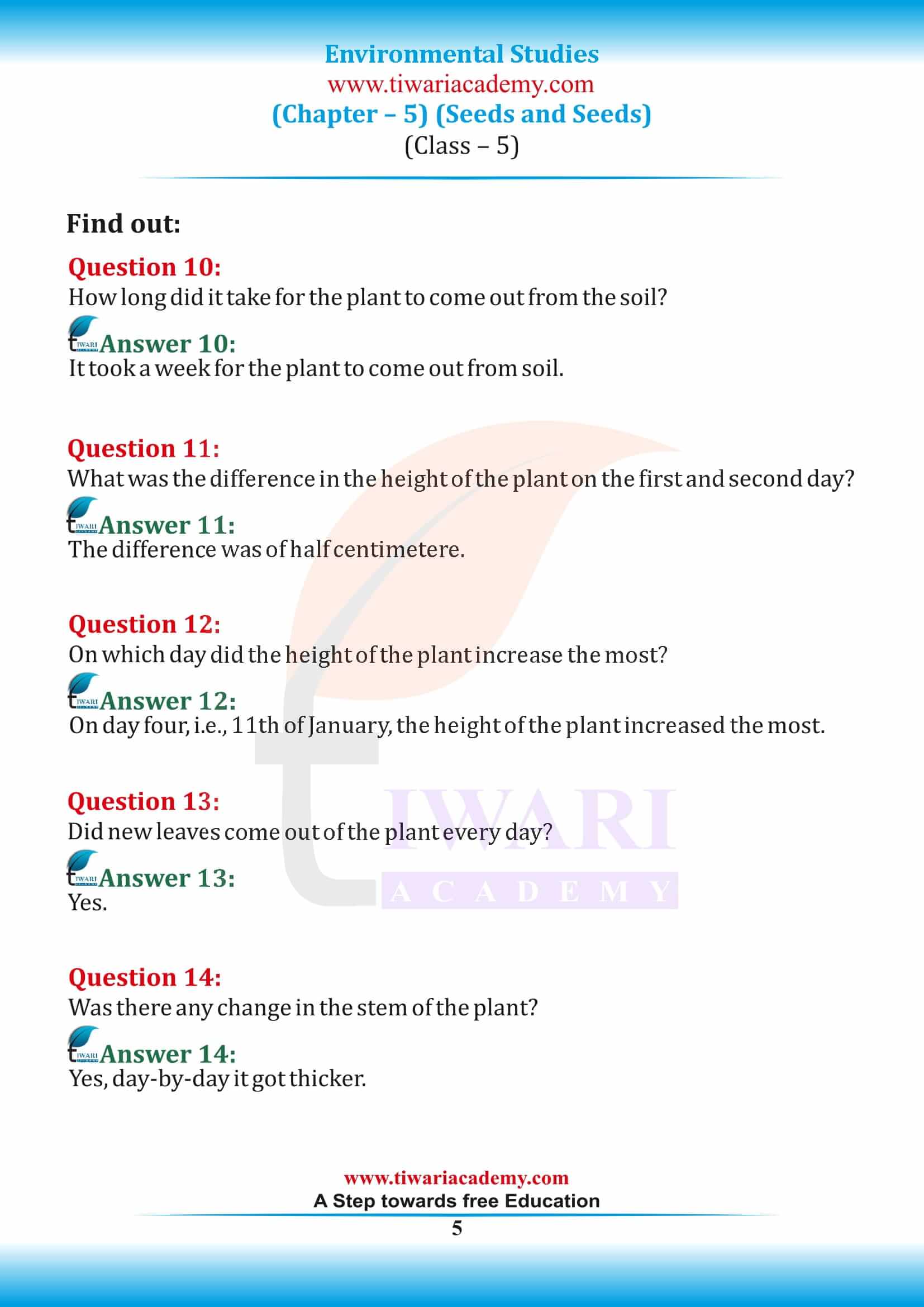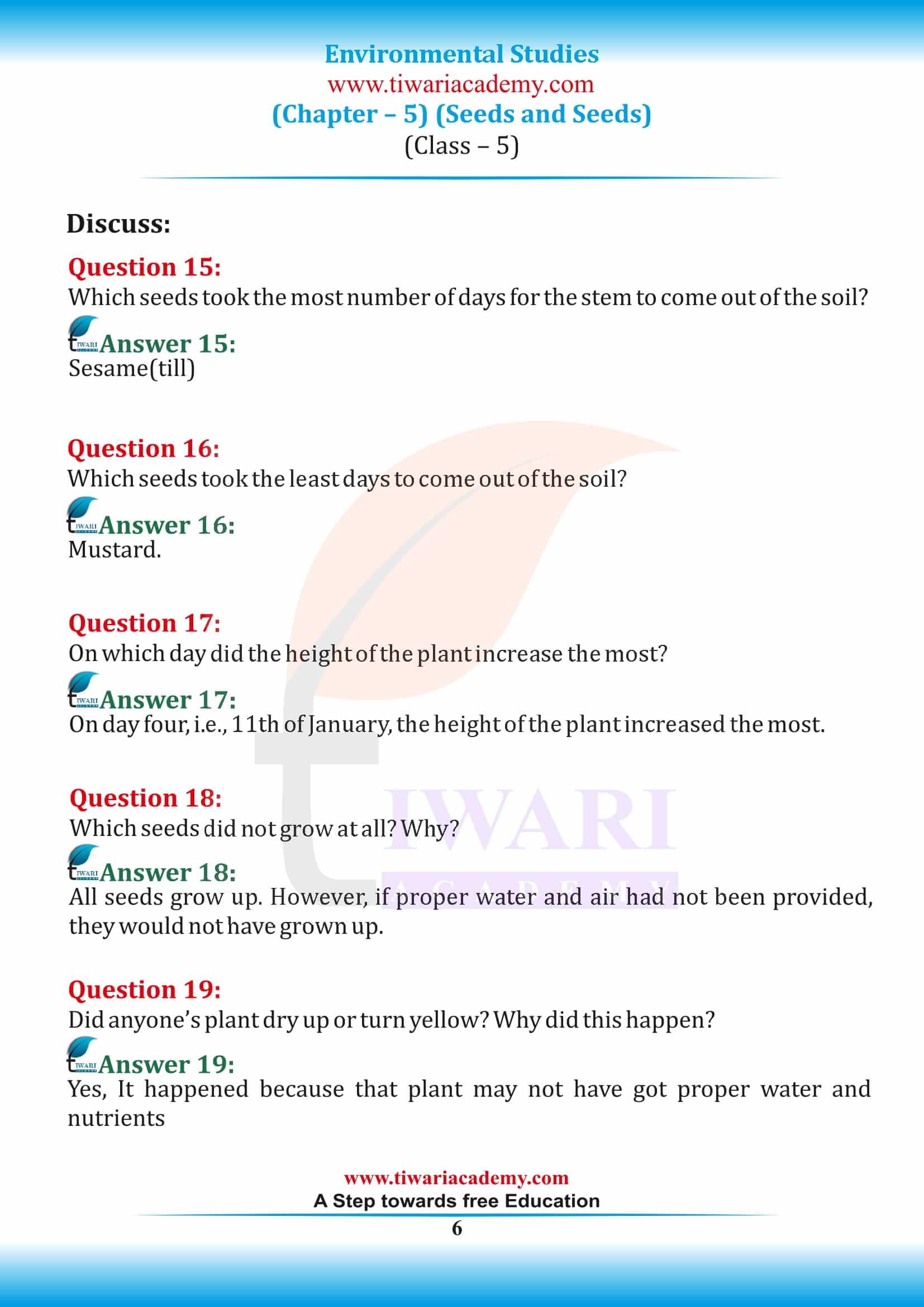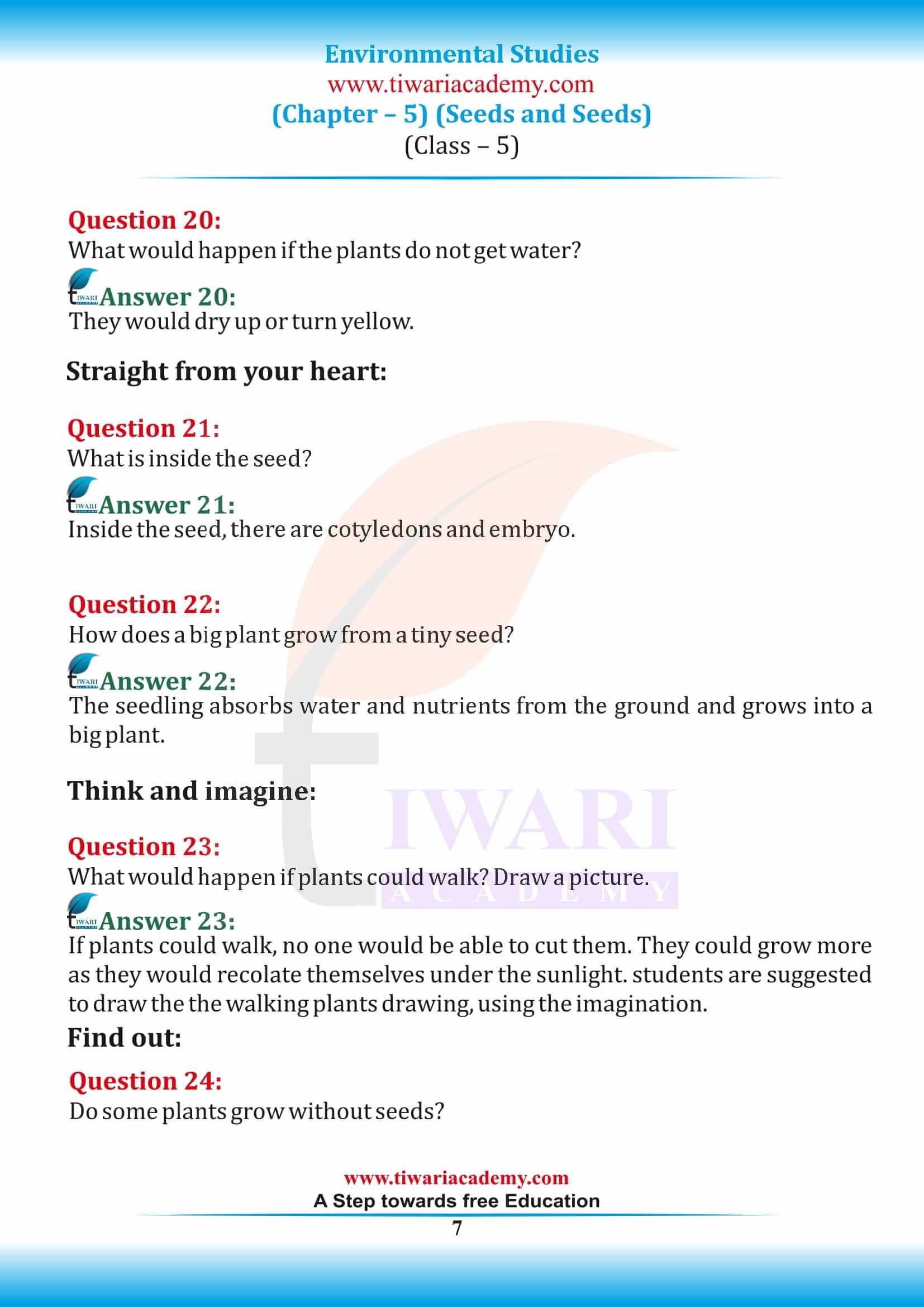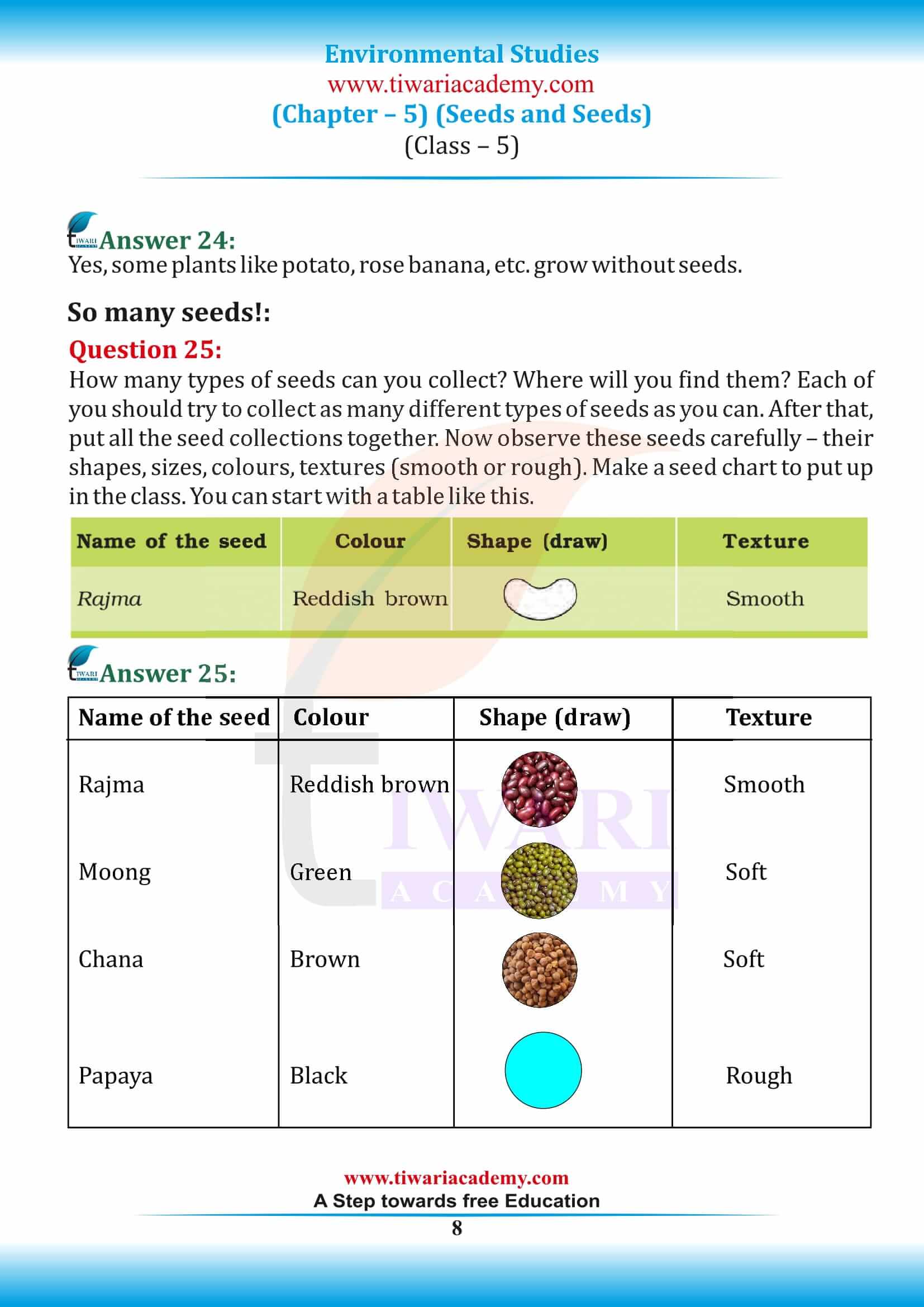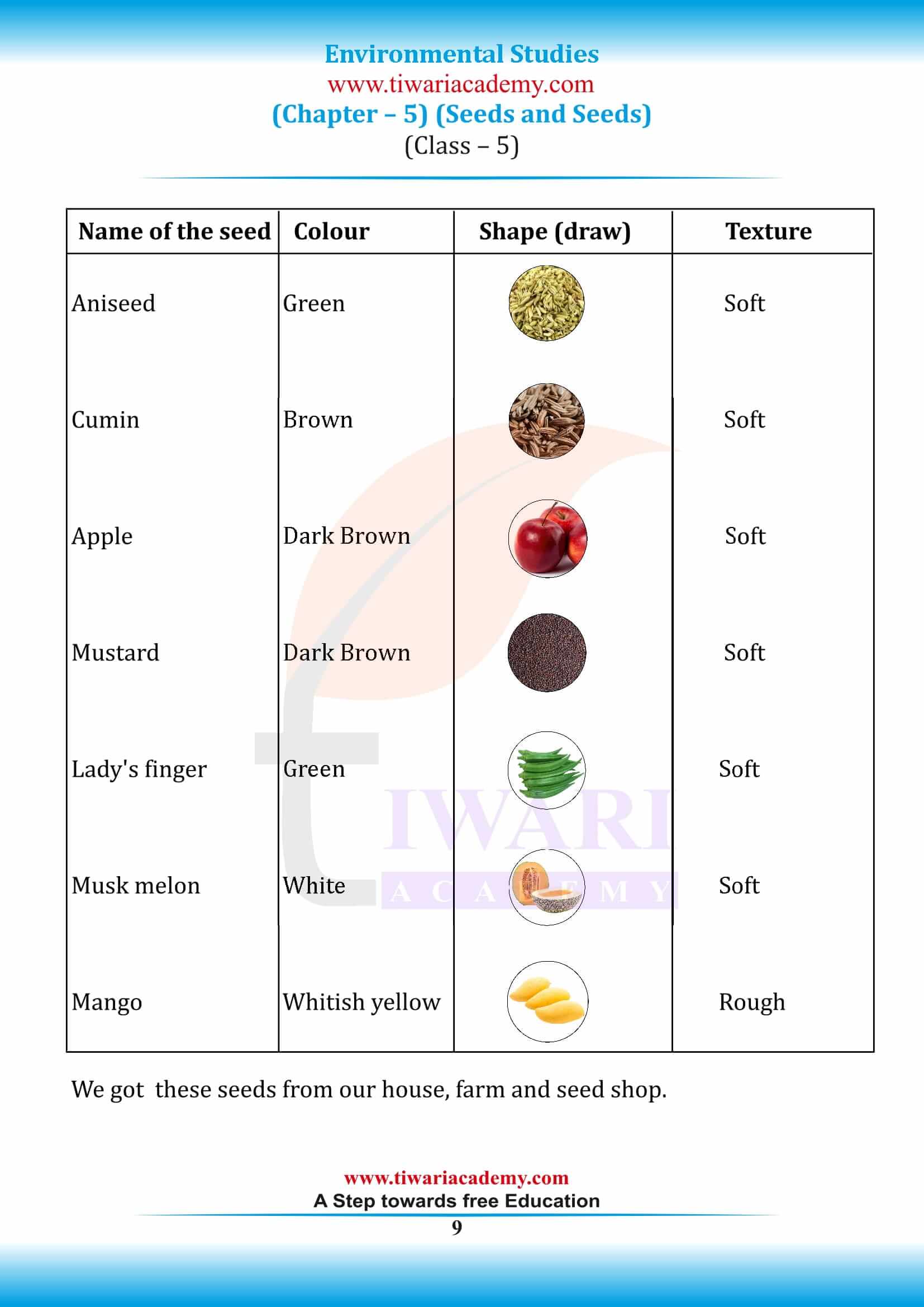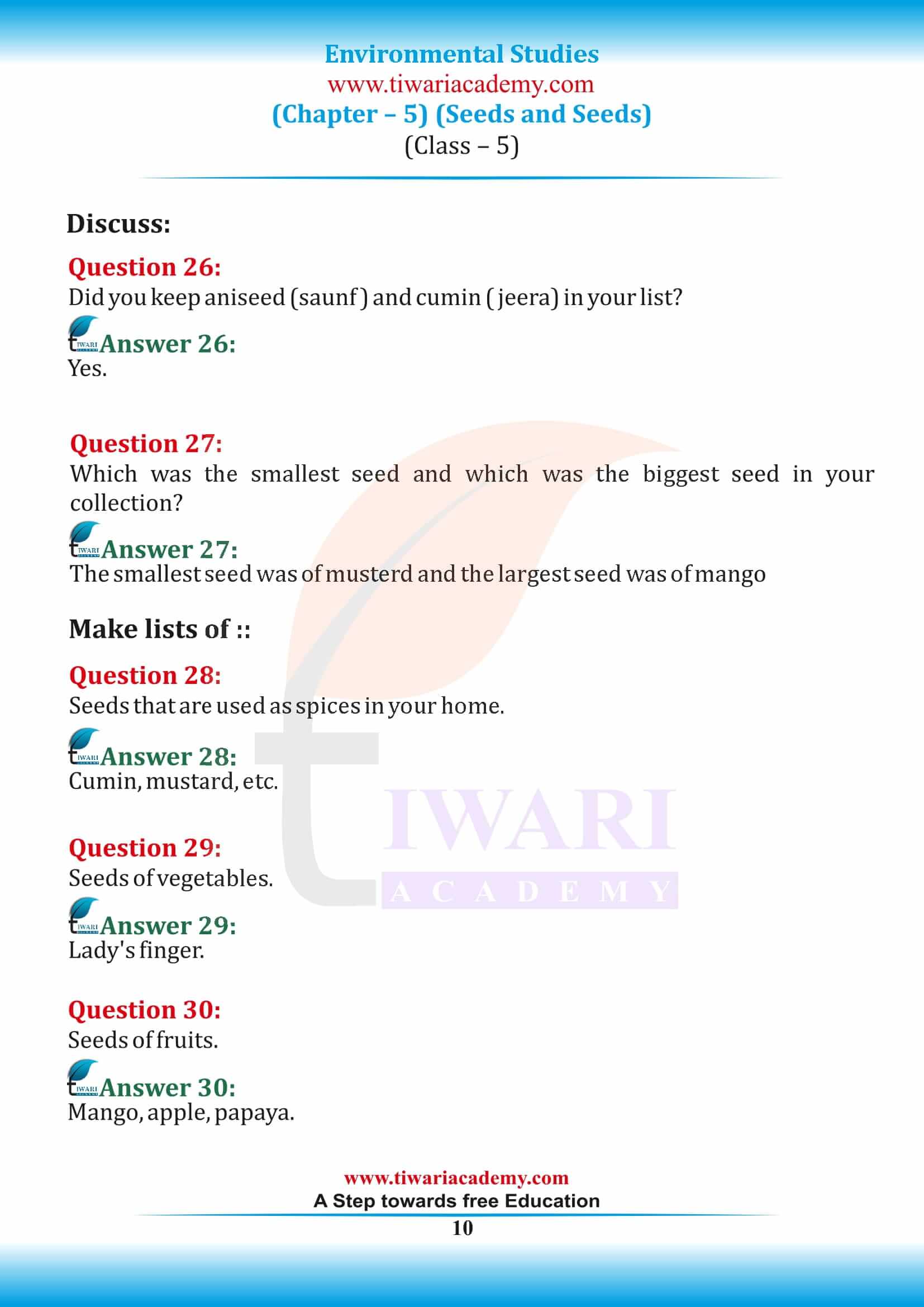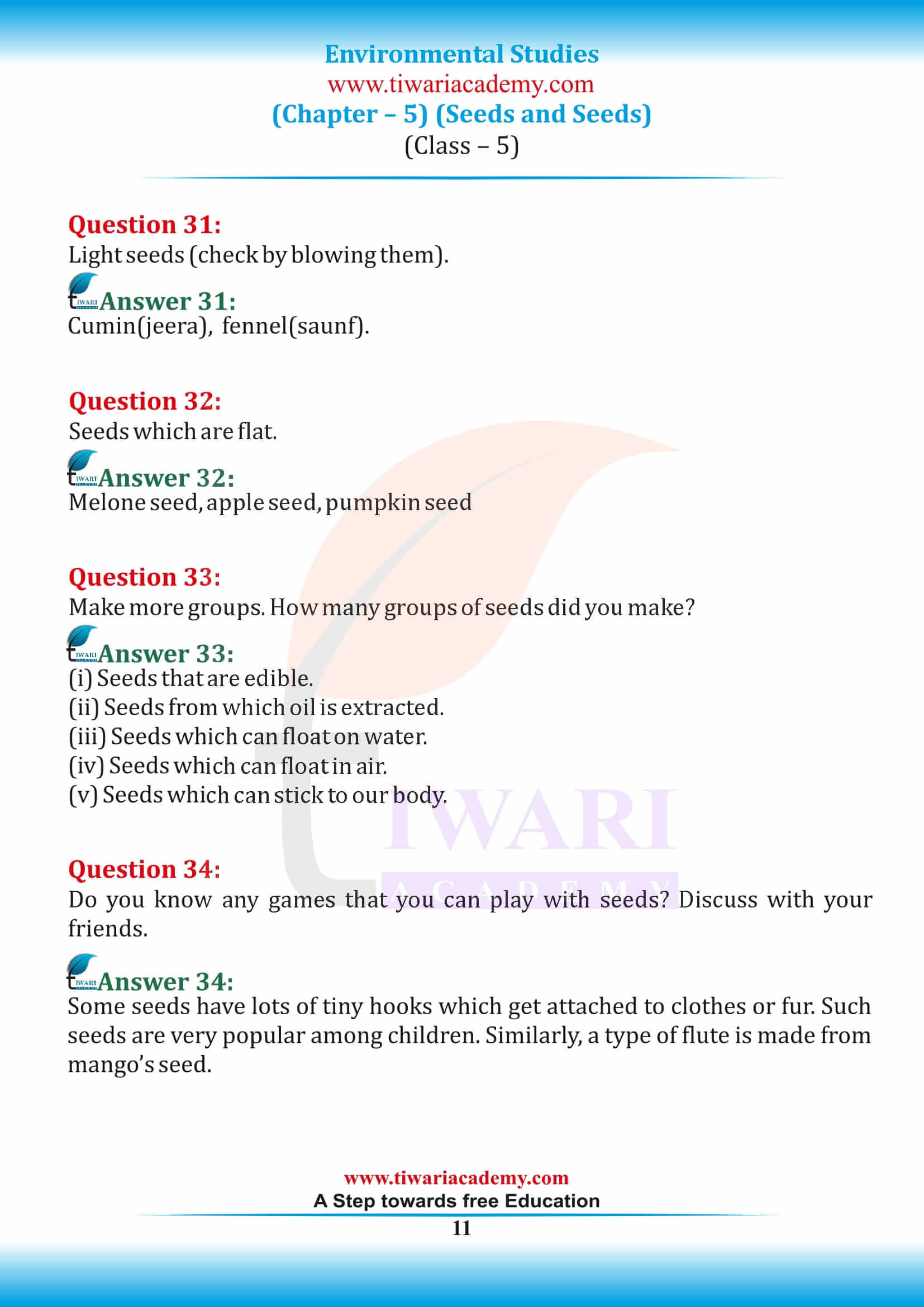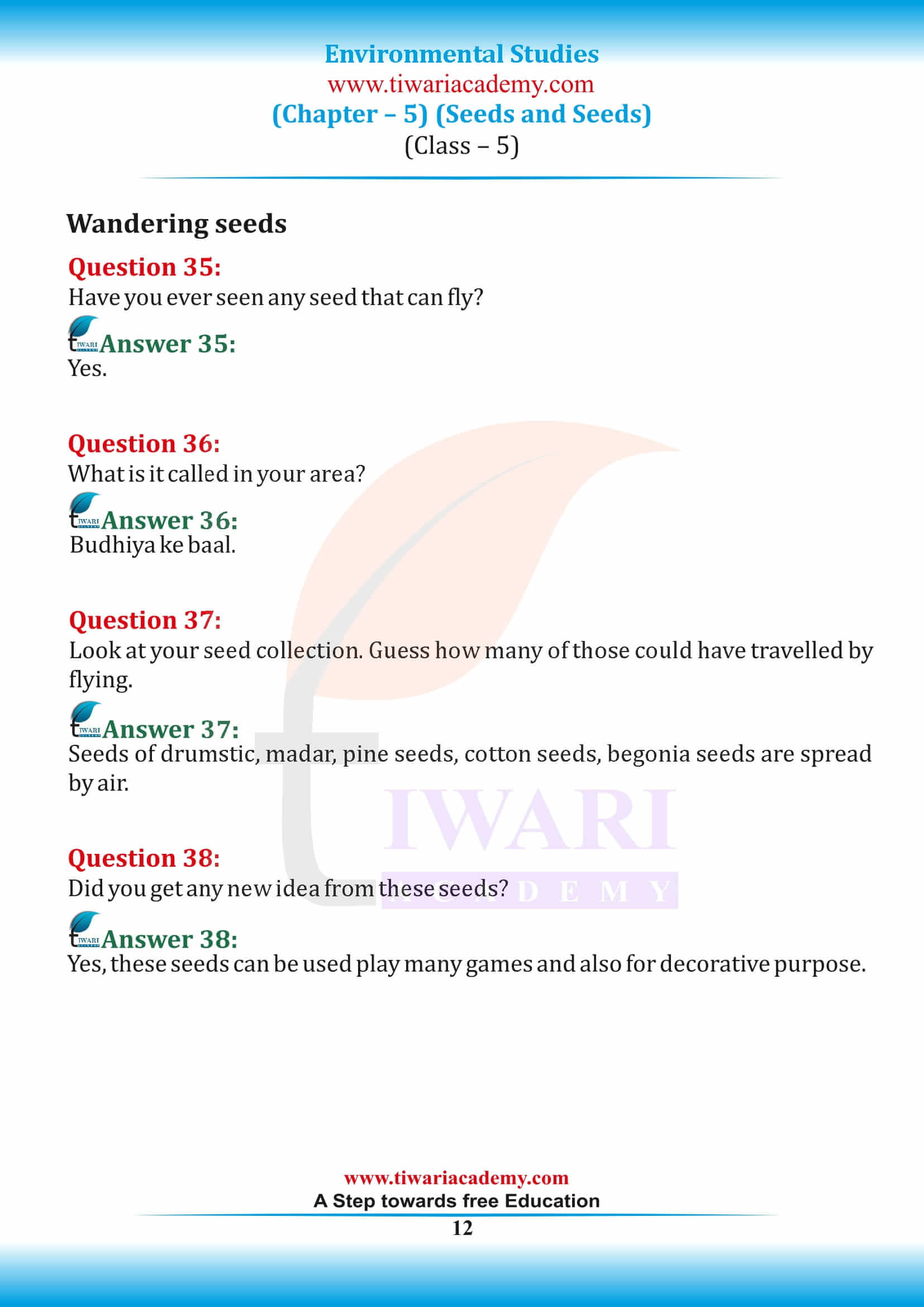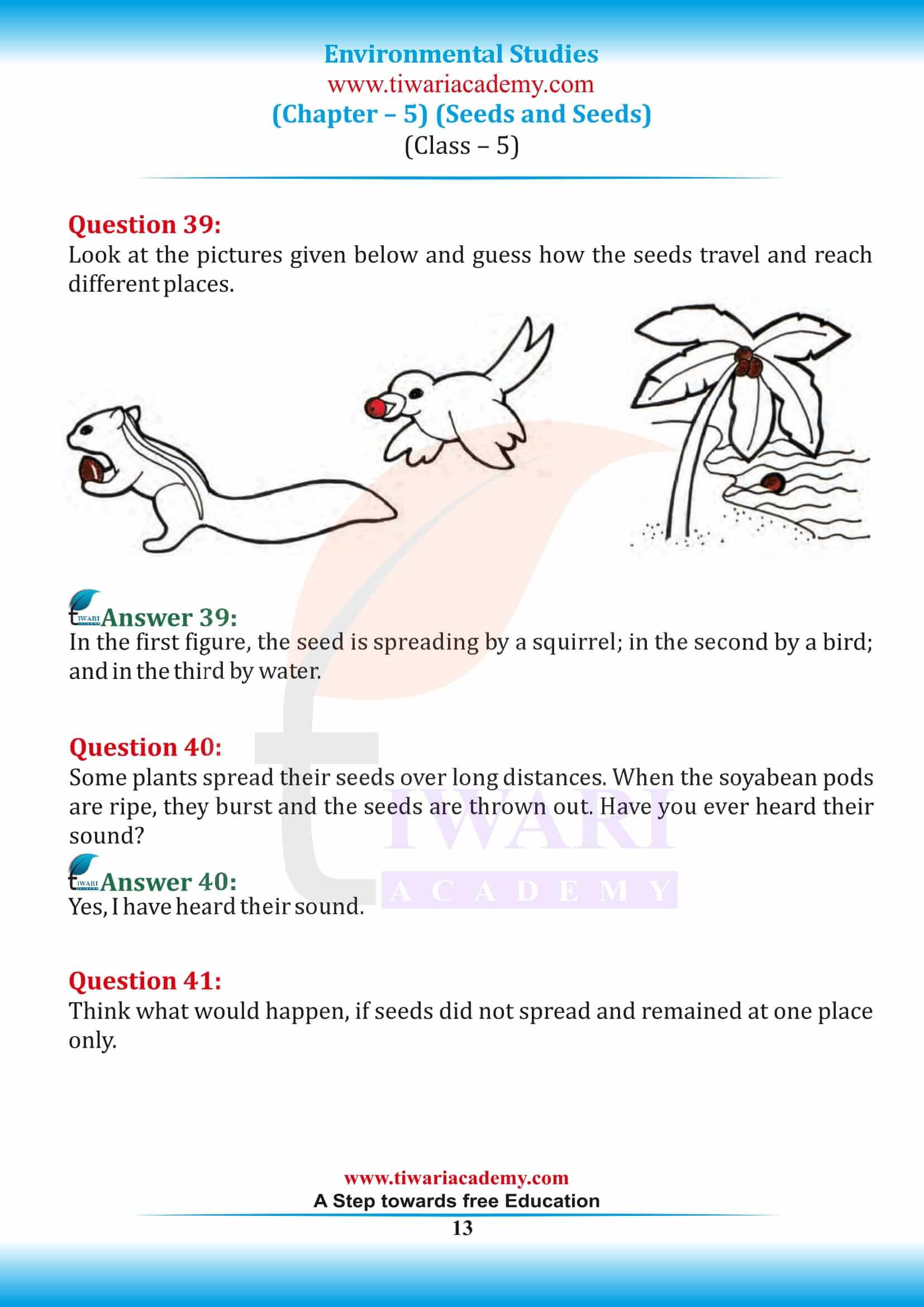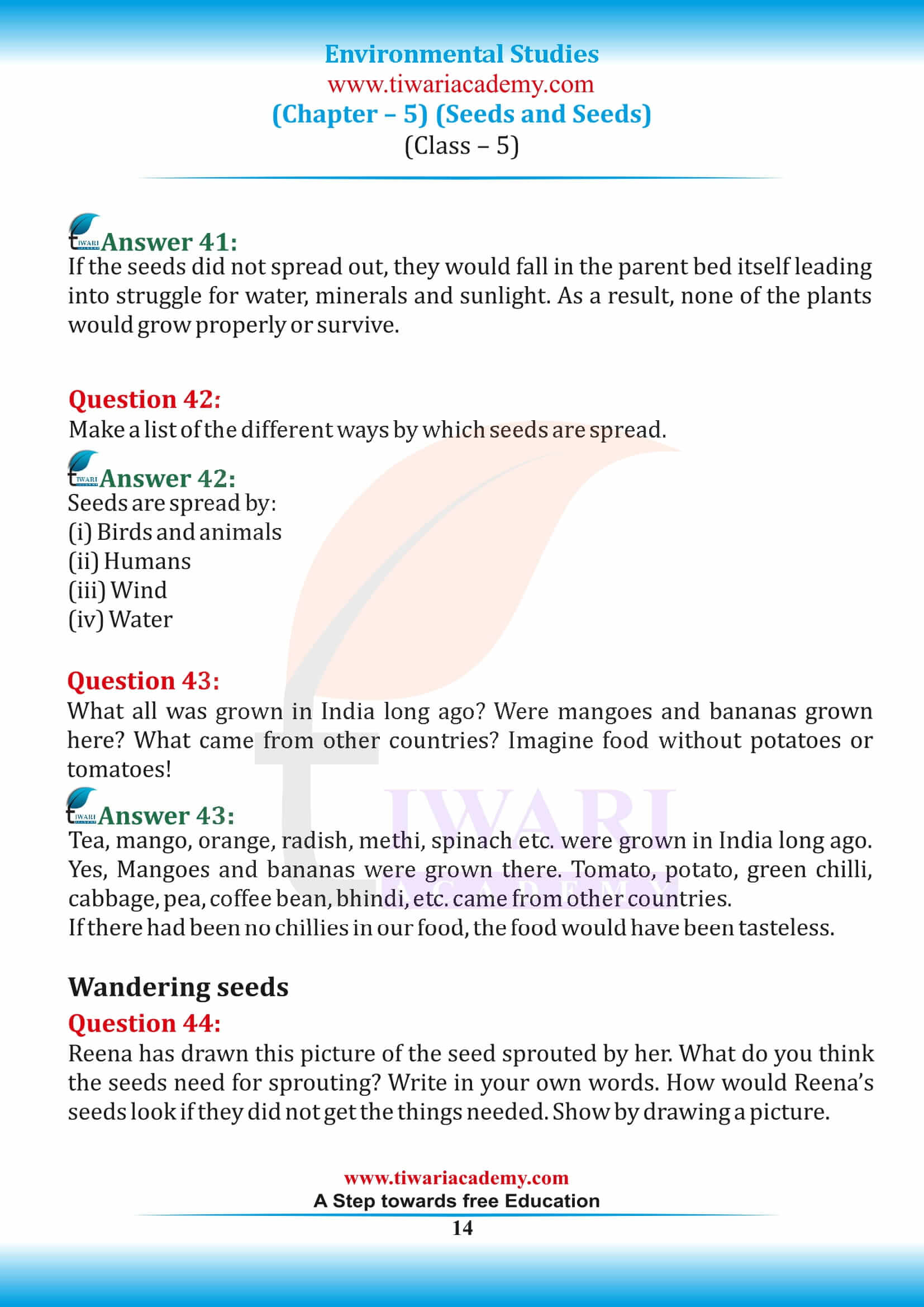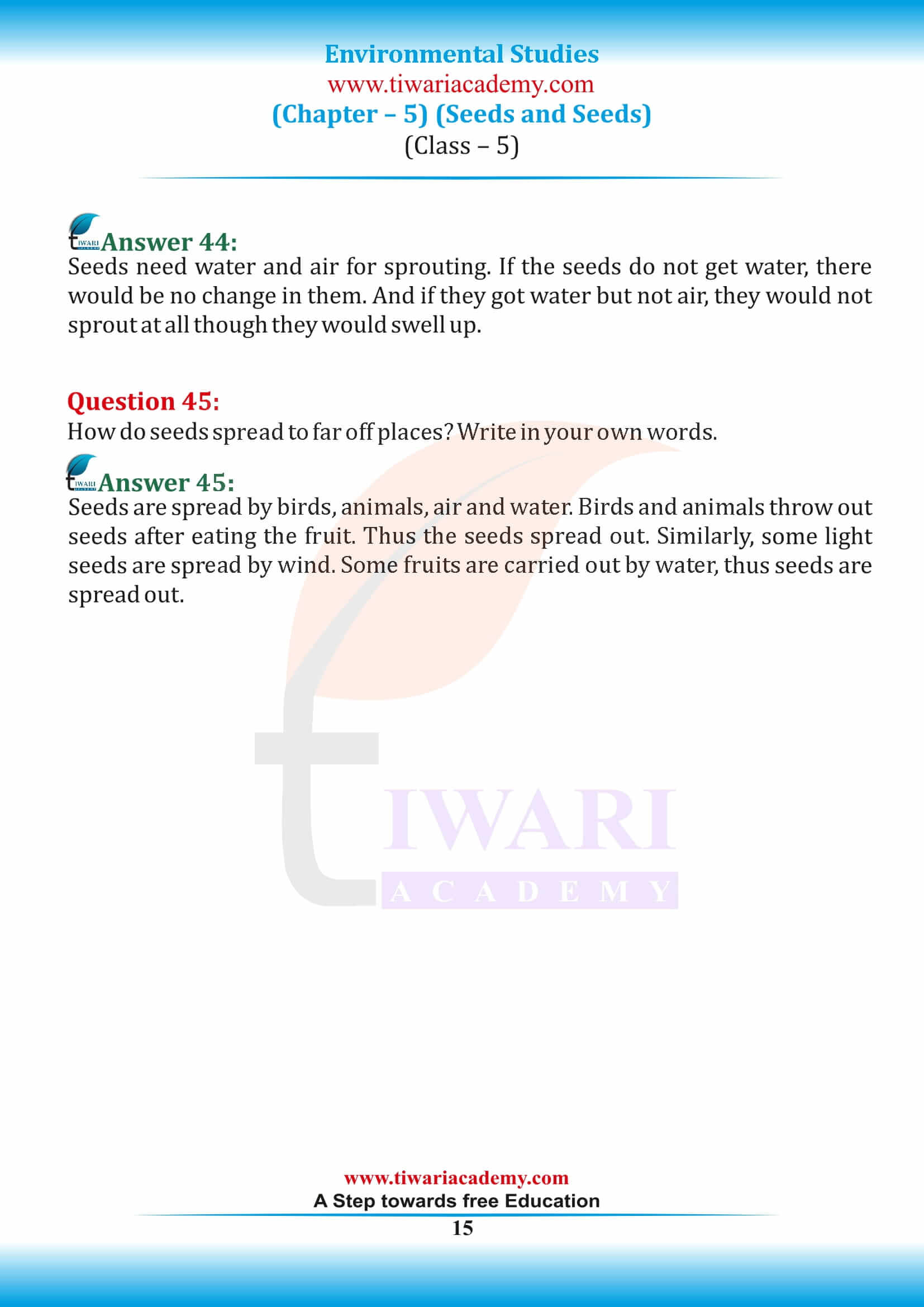NCERT Solutions for Class 5 EVS Chapter 5 Seeds and Seeds in Hindi and English Medium updated for new academic session 2025-26 based on latest CBSE Syllabus. After going through NCERT Question Answers, student must do the extra important questions to prepare for exams. These questions are useful to revise the entire chapter for tests.
NCERT Solutions for Class 5 EVS Chapter 5
Class 5 EVS Chapter 5 Question Answers of Seeds and Seeds
Class 5 EVS Chapter 5 Question Answers Set 1
What is germination?
Germination is the process by which a seed grows into a new plant when it gets all the necessary things like air, water, etc from the soil for its proper growth.
What are the conditions required by a seed to grow into a plant?
The conditions required by a seed to grow into a new plant are –
• moisture (water)
• air for sprouting
• warmth of the sunlight
• proper space
• nutrients from the soil
If the seeds do not get the right amount of moisture and air they will not sprout at all.
How does a seed become a plant?
The process of seed becoming a plant involves following steps
• As the seed takes up more water, the seed expands and the seed coat cracks open.
• The embryo inside the seed consists of a small shoot and a small root.
• The root is the first part to emerge from the seed.
• Once these roots develop, a small plant will begin to emerge and in due time break come out of the soil.
• As the seed grows into a plant, it anchors it to the ground, and starts absorbing water through the root.
• As the plant grows it starts making its own food from nutrients present in the soil
• It then grows into a fully grown plant.
Name any four seeds which are eaten by us.
Four seeds eaten by us are cumin, aniseed, sesame, bean.
What does a seed have inside it?
Seeds have a seed coat that protects them when they are growing and developing, usually underground. And inside the seed we have an embryo which is the baby plant and cotyledons. When the seed starts growing, the upper part of the embryo becomes the plant while the lower part becomes the root of the plant.
What are cotyledons?
Cotyledons are that part of the embryo which is inside the seeds and it form the first leaves when the plant germinates. They store food for the embryo and supply it to the baby plant to provide the primary energy that it needs to grow. Thus cotyledon is the seed leaf which is within the embryo of a seed.
What are the two types of cotyledons?
The two types of cotyledons are Dicots and monocots
• Some plants like flowering plants have embryos with a single cotyledon are called as monocots, or monocotyledonous plants
• Some plants whose embryos have two cotyledons are called dicots or dicotyledonous plants
How was Velcro discovered?
In the year 1948, George Mestral came back from a walk with his dog. He saw seeds sticking all over his clothes and his dog’s fur. He was amazed to see this. He thought what could be the reason to make them stick. He observed these seeds under a microscope and found that the seeds had many tiny hooks which got stuck to his clothes or fur. This gave him the idea of making Velcro. He made a material with similar tiny hooks that would stick. Velcro is used to stick together many things – clothes, shoes, bags, belts etc.
Question:
How are the monocots different from dicots?
Answer:
| Dicotyledon | Monocotyledon |
|---|---|
| Two cotyledons are present in the embryo | Cotyledon is thin and small and lack stored food |
| Example-beans, cauliflower,apple,pear | Cotyledon is thin and small and lack stored food |
| Example-beans, cauliflower,apple,pear | Example: garlic, corn, onion |
Class 5 EVS Chapter 5 Question Answers Set 2
How was Velcro discovered?
In the year 1948, George Mestral came back from a walk with his dog. He saw seeds sticking all over his clothes and his dog’s fur. He was amazed to see this. He thought what could be the reason to make them stick. He observed these seeds under a microscope and found that the seeds had many tiny hooks which got stuck to his clothes or fur. This gave him the idea of making Velcro. He made a material with similar tiny hooks that would stick. Velcro is used to stick together many things – clothes, shoes, bags, belts etc.
How do the plants reproduce?
A flower can have the male or the female part or both the parts. Flowers in plants is responsible for carrying out the reproductive functions in plants when both the male and female gametes are fused, they produce the seeds which bear the fruit. These seeds are then germinated to produce new plant structures.
In asexual reproduction, new plants can be obtained without the production of seeds. It is a reproduction in which new plants are produced from roots, stems, leaves and buds. As this reproduction is possible through the vegetative parts of the plant, it is called vegetative propagation.
Why do the seeds that are kept in an airtight container do not sprout?
Seeds that are kept in an airtight container do not sprout because they do not come in contact with air and water (moisture) which are essential for their growth. As Plants need water and moisture to grow and if they are kept in air tight container, they are deprived of these two things required by them to sprout or grow.
Why do the seeds which are kept in refrigerator do not sprout?
For proper germination of seeds, air, water and most favourable temperature (20 to 250C) is required.
But the temperature inside refrigerator is very low, so the seeds do not sprout when kept inside the refrigerator.
Why do we need to leave space when we scatter the seeds.? Ans,
It is essential to leave proper space between the seeds while sowing the seeds because they need to be given enough space to grow and expand. To ensure that the seeds get proper space and nutrients required for their growth, overcrowding of plants needs to be prevented. If too many seeds are put together at one place then the seeds will not be able to get proper air, water or space required for their growth.
What are the three things which a farmer needs to keep in mind while sowing seeds? Ans.
The three things which a farmer needs to keep in his mind are-
1) Seeds need to be grown at a proper depth
2) They need to be sown at a proper distance away from each other, avoiding overcrowding.
3) seeds used for sowing should be clean, healthy, and free from any disease or infection.
What do you understand by seed dispersal?
Seed dispersal is the movement of the seed from one place to another. It is the process by which the seeds are spread or transported away from the parent plant.
Why is seed dispersal necessary?
Seed dispersal is necessary for the survival of plant species. If plants are grown closely and with each other without leaving space, they have to fight for light, water and nutrients from the soil. Thus, seed dispersal allows the plants to spread out to a wide area and keep away from competing with one another for the same things essential for their proper growth.
Class 5 EVS Chapter 5 Question Answers Set 3
How is seed dispersal useful for plants?
Seed dispersal is useful for the plants as:
(i) it stops the overcrowding of plants in an area.
(ii) It prevents the competition for resources like water, minerals and sunlight among the same kind of plants.
(iii) It helps the plants to grow in new habitats and thus helps in wider distribution.
What happens to the cotyledon when the plant starts growing?
Cotyledon is an important part of the plant embryo within the seed. It is responsible for storing food materials that is to be supplied to the seeds during germination. After germination, the cotyledons become the first leaf of the seedling and as the seedling grows into a small plant with new leaves, the cotyledon dries up and falls down.
How can the seeds spread too far off places?
Seeds spread too far off places through a process called seed dispersal. Seeds are carried away by birds, animals, air and water from one place to another place. The birds and animals eat the fruits and throw away the seeds. Some light weight seeds get carried away by the blowing winds. Some seeds are carried by flowing water. So there are different agents of seed dispersal which help in spreading or scattering the seeds too far off places.
Explain the role of wind as an agent of seed dispersal.
Wind is a natural and important agent of seed disposal. This method of dispersal is usually seen in those plants which have very light seeds. For example -the seeds of the orchid plant, dandelions, swan plants, cottonwood tree are those plants whose seed are dispersed by the wind.
How does water help in seed Dispersal?
Seed dispersal by water is method of seed dispersal i n which the seeds float away from their parent plants or are carried away by the running water bodies. This method is common in those plant which live and grow in water or are nearby water bodies like beaches, lakes, ponds etc. For example- Coconut, palm, mangroves, water lily, water mint, are those plants whose seed are dispersed by the water.
How do humans, animals and birds disperse seeds?
Seed Dispersal by humans, animal and birds- There are many ways in which animals and birds disperse the seeds.
• Few animals and birds are attracted to bright colourful fruits which they eat but only the juicy part gets digested by them and the seed is excreted out in the form of their dropping, which forms a new plant. Example- Blackberry, cherry, tomato and apple seeds are dispersed in this way.
• squirrels collect nuts from some plants and bury them under the soil as stored food for the winter season. They at times forget the place where they had buried them and the seeds grow into new trees.
• few plants bear seeds with hooks which catch on the clothes, hair of humans or the fur of animals and are carried away to different and far off places from their parent plants.
• Dates, sea grapes, tamarind, raspberry, sunflower, tomatoes are a few examples of plants whose seeds are dispersed by animals and birds.
What role does gravity play in seed dispersal?
Gravity is a force of attraction that is present among all the objects in the universe. When the fruits from the tree fall on the ground due to the force of attraction, they roll down to some smaller distance, get buried in the soil and germinate into a new plant. In some cases, fruits that do not have a very hard seed coat crack open when they fall from a height, which leads to seed dispersal. Example-Apples, passion fruit.
What is Seed Dispersal by Explosion?
Seed dispersal by explosion means bursting of a fruit with all its energy. When the fruits get ripened, they shoot out the seeds into the outer environment. This type of seed dispersal is mostly found in the plants having pods. Pea, ladyfinger and bean plants also have pods and the seeds burst out when they ripen and pod has dried.
Question:
What are insectivorous plants?
Answer:
Insectivorous plants are those plants that gain most of their nutrition and energy by trapping the
insects and consuming the insects. For eg., Venus flytrap, Bladderwort, etc.
Class 5 EVS Chapter 5 Question Answers Set 4
Why do some plants like pitcher plant feed on insects?
Some plants feed on insects because these plants also called insectivorous plants grow in such soil which does not contain adequate nitrogen in it. So, insectivorous or carnivorous plants feed on insects to obtain the to fulfil their nutrient requirement which is the nitrogen needed for their growth.
What would happen if the plants do not get proper water?
If too much of water is present in the soil then the roots can rot, and the plant will not get enough
oxygen from the soil. Similarly, if a plant does not get enough water, the nutrients it needs will not travel
through the plant. A plant will not be able to grow properly if it doesn’t have healthy roots, so the proper
balance of water is essential for the plants.
How does a big plant grow from a tiny seed?
A big plant grows from a tiny seed as the seed contains an embryo which is a group of cells which are
ready to form roots, a stem and the first leaves. Once the coat around the seed gets moistened, the embryo
cells expand and bursts out.
i) Name the plant in the given picture. ii) Why does it feed on insects inspite of having chlorophyll to make its food?
i. The plant is Pitcher plant.
ii. The Pitcher plant feeds on insects inspite of having chlorophyll to make its food, to get certain
nutrients(nitrogen) which it does not get from the soil in which it grows.
What would happen if seeds are not dispersed too far off places?
If the seeds are not dispersed too far off places then it will result in over -crowding of the seeds at one place and they might not get enough sun, water or nutrients from the soil and it will affect their growth and development.
How do the non flowering plants reproduce?
The non-flowering plants reproduce by cones and spores.
Why do the doctors advise to eat sprouts?
Doctor advise to eat sprouts because they are very nutritious. Adding sprouts to our diet can give us the essential proteins required by our body and reduces the fat, cholesterol and calories. Once sprouted, the quality and fibre in the beans, nuts, seeds and grains also improves. Eating sprouted grains helps us to maintain a healthy immune system.
Class 5 EVS Chapter 5 Question Answers Set 5
How does a pitcher plant trap its prey?
The pitcher plant has a sweet smell that attracts the insects. When the insect comes near the pitcher plant, it slips into the pitcher shaped plant and the leaf lid closes its mouth. As a result, the insect trapped inside the plant is unable to come out.
Briefly explain the structure of seed.
Seed is the reproductive part of a plant which is made up of a seed coat and an embryo. The other parts of a seed are plumule, radicle and cotyledon. The embryo is made up of a radicle and one (wheat, maize) or two cotyledons (gram and pea). A seed is inside a fruit which changes into a new plant. Hence, the seed is the most important part.
What functions does the seed perform? Ans.
The seeds perform the following functions:
• They help in growth of the new plant.
• They contain food stored in the form of cotyledons.
• The seed coat protects the embryo inside the seed.
Define Seed coat, radicle, plumule.
i. Seed Coat- It is the outermost covering of the seed which it protects the seed from the external moisture and insects.
ii. Plumule is the embryonic shoot of the plant. Plumule grows after the radicle. The plumule is that part of the embryo that develops into the shoot and bears the leaves of the plant.
iii. Radicle is the first part of the seedling and grows downward in the soil. The radicle makes the root of the plant to allow the seed to take water and send out its leaves so that photosynthesis starts.
Give few examples of non flowering plants.
Some of the non-flowering plants are ferns, liverworts, mosses, hornworts, whisk ferns, club mosses, horsetails, conifers etc.
Why is the process of reproduction necessary for plants?
The process of reproduction is necessary as it helps the plants not to disappear from Earth. This process is very important as it maintains firmness in the ecosystem and helps in continuation of life on earth.
Question:
How does a plant trap insect?
Answer:
A plant which insects or is an insectivorous plant has special or modified plant parts which trap insects. The mouth of these insectivorous plants have hair-lined edges which help it to move instantly or shut immediately as soon as the insect touches the hair thus trapping the insects.
Is chapter 5 of 5th class EVS tells us about the food?
After reading the chapter I found that the chapter actually doesn’t tell us about the food but the plants and seeds as the title of the story suggests. The story tells us a different type of seeds and the way they consume the nutrition from water so that they consume and sprout their way up and grew like a plant.
Does this chapter tell us about the nature of the greenery and plants in 5th Class EVS in chapter 5?
The chapter does not only tell us about the seeds and sprouts it does tell us about the wild trees that hunt the prey and get its nutrition out of it. The point that the chapter made here is to shoe the biodiversity among the plant and the way they found the nutrition to survive.
What do you like about chapter 5th of class 5th EVS NCERT?
The chapter informed us of various important things about plants and seeds. However, the best part about the chapter is the story of the plant that prey on even large rodents like mice because we all knew the plants are alive but they are stationary however looking into the fact that there are certain plants that can prey.
